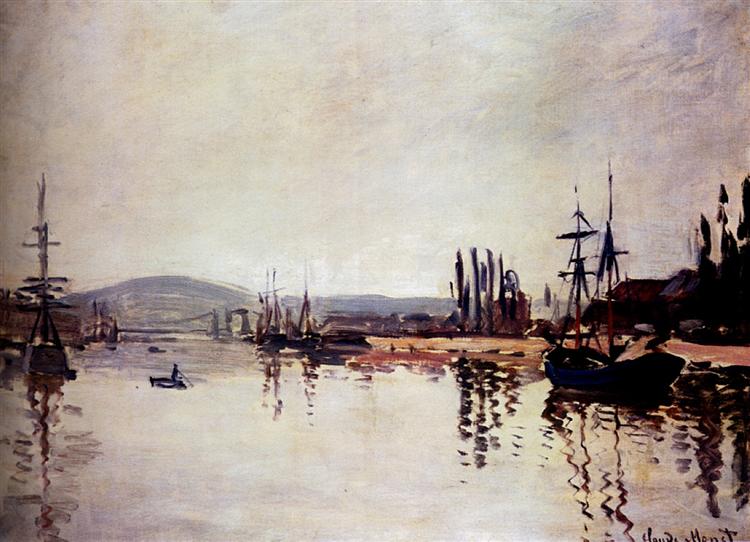תיאור
Claude Monet's "The Seine Below Rouen" (1872) is a vibrant and luminous depiction of a natural landscape that captures the essence of the Seine River as it flows through the Rouen region of France. This painting is a notable example of the Impressionist style, a movement that Monet helped define and popularize in the 19th century. Through this work, the viewer is led to experience the light, color, and atmosphere of the natural environment, elements that Monet mastered with mastery.
The composition of the painting is a testament to Monet's approach to landscape. Below, the river meanders, reflecting the sky and surroundings in a subtle play of light and shadow. The brushstrokes are loose and dynamic, suggesting the movement of the water and the vibrant life around it. Monet uses a color palette that ranges from the deep blue of the Seine's waters to the warm gold and orange hues of the sky, creating an immersive contrast that highlights the immediacy of the moment captured.
In the work, one can observe the presence of barges on the water, which are silent witnesses of the river and commercial activity that has characterized the area. However, there are no prominent human figures in the scene; the focus is on the relationship between nature and the river, suggesting an intimate contemplation of the landscape. This absence of characters can be interpreted as a way of bringing the viewer closer to the experience of the environment, almost like a whisper of the serenity that nature offers.
One of the most interesting features of "The Seine Below Rouen" lies in the application of impressionist techniques. Monet combines various layers of color to create a depth that brings the scene to life. Through his technique of short, rapid brushstrokes, he manages to evoke the effect of light filtering through clouds and suggests the time of day when it was painted; probably a moment close to dusk, when the atmosphere becomes soft and contemplative.
In addition to its aesthetic quality, this work is also significant in the context of the evolution of landscape in art. During Monet's time, the landscape had begun to be seen not just as a background for the human figure, but as a subject in itself. In "The Seine Below Rouen," Monet gives prominence to the river and its surroundings, making them the central axis of the visual experience. This approach to the perception of nature is a testament to Monet's ability to transcend the purely pictorial and invite the viewer into a deeper reflection on the natural world.
This canvas is not only a display of Monet’s virtuosity in the use of color and light, but also a representation of the impressionist landscape that resonates with the search for beauty in the everyday. When viewing it, we are invited to immerse ourselves in the serenity of the Seine and enjoy not only the work, but the dialogue between nature and art, a relationship that Claude Monet has explored and concretized throughout his career. The work is a legacy of artistic modernity that continues to influence and attract artists and viewers alike, fostering a renewed appreciation for the passage of time and the majesty of nature.
KUADROS ©, a famous painting on your wall.
Hand-made oil painting reproductions, with the quality of professional artists and the distinctive seal of KUADROS ©.
Painting reproduction service with satisfaction guarantee. If you are not completely satisfied with the replica of your painting, we will refund 100% of your money.

